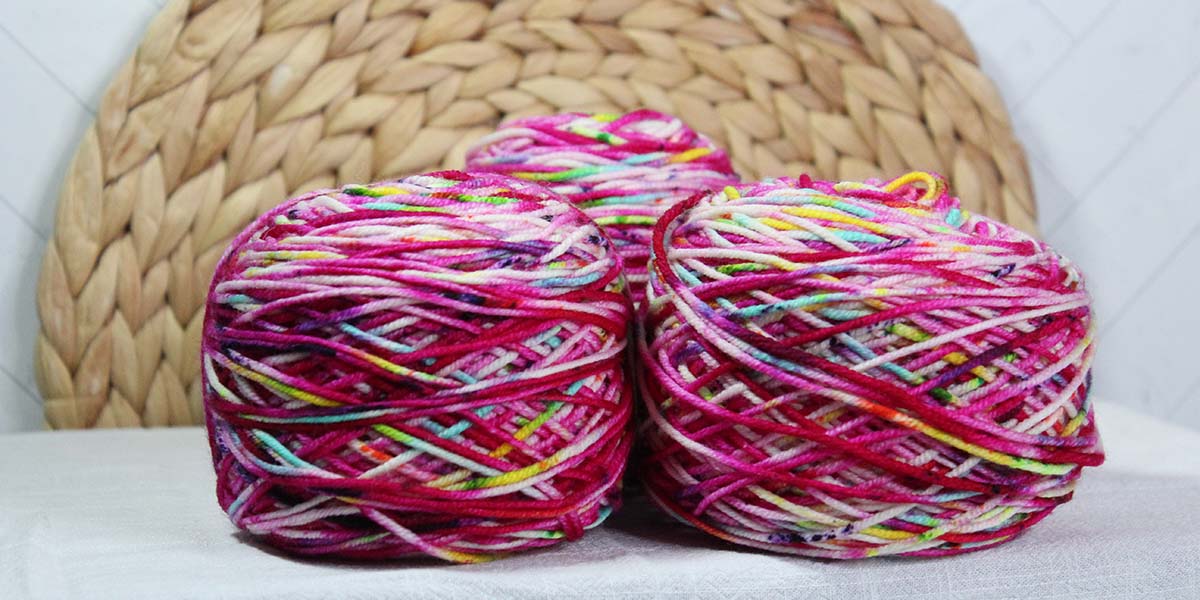Your cart is currently empty!

Ultimate Yarn Guide: Animal, Plant, and Synthetic Fibers Explained
Whether you’re casting on your first project or you’ve got years of stitches under your belt, understanding the different types of yarn can transform your knitting journey. Picking the right material can make or break your project, so be sure to consider it as a factor when you are creating. It’s more important than the color or even the weight!
The three main types include Animal, Plant, and Synthetic
We aren’t going to get into the ethics of each material type, but simply an overview of what each can be useful for. While there are strong teams for specific types of yarn based on environmental factors or preferences, the important part is to understand what they are and what they are good for. Then, you can make your own informed decision about what works for you!
The Go-To Material: Animal Fibers
From the common, versatile wool to the luxurious cashmere and the incredibly soft alpaca, each type of animal fiber brings its unique charm to your needles. Wool, for instance, is a bit of a “jack-of-all-trades”, perfect for everything from hearty winter sweaters to those socks you won’t want to take off. When folks think of the fiber arts and yarn, you can bet that wool is the first thing that comes to mind.

There are a lot of different animal types. Their uses can vary. For example, mohair can add that light yet warm layer for cooler evenings. For those special pieces for a gift for someone dear, cashmere and silk offer unmatched softness and sheen. Have allergy concerns? Yak might be the one you reach for, as most folks have an easier time with yak over say alpaca.
More details on each animal fiber and what they work best with is below:
- Wool:
- Types: From the ultra-soft Merino to Organic wool rich in lanolin.
- Projects: Ideal for sweaters, mittens, and cozy scarves.
- Care: Watch out for felting; opt for “superwash” for machine washability. Scroll down for a special section on what superwash is, its considerations, and what it means for you as a crafter.
- Alpaca:
- Traits: Softer, warmer, and more stretchable than wool.
- Projects: Perfect for lightweight sweaters and luxurious shawls.
- Care: Depending on the blend, alpaca for the most part is a delicate fiber that isn’t great in a washing machine.
- Mohair:
- Traits: Known for its luster and sheen, providing lightweight warmth. Typically paired with another yarn in a project and acts as an add-on, although it can be used solo.
- Projects: Beautiful in lace work and accessories like scarves, but the go-to is probably a sweater. Be careful though, if you overheat easy, a mohair sweater might not be so great for you because it’s REALLY warm!
- Cashmere:
- Luxury: Softer, lighter, and warmer than traditional wools.
- Projects: For those special luxury scarves and baby clothes.
- Care: Be very careful with cashmere! It shrinks super easily! Your adult sweater might turn into a child sized one if you accidentally throw this in your washing machine.
- Silk:
- Features: Strong, smooth, with a high sheen.
- Projects: Ideal for fine shawls and blend sweaters for a touch of luxury. Anything close to the skin benefits from silk, especially hats or head pieces for hair.
- Angora:
- Unique: Extremely lightweight and up to eight times warmer than wool.
- Projects: Soft, fluffy scarves and anything that needs a touch of luxury.
- Yak:
- Traits: Luxuriously soft, warm, and comparable to cashmere in fineness.
- Benefits: Hypoallergenic, excellent moisture absorption, and retains warmth well.
- Projects: Ideal for cozy winter garments like sweaters, hats, and scarves.
Take a Breather with Plant Fibers
Moving on to plant fibers, which are a breath of fresh air for our warmer weather projects. Cotton and linen stand out as the go-to choices for that summer top or even a cool pair of shorts or pants. Bamboo yarn, with its sustainability and softness, is perfect for those eco-friendly baby garments. Each plant-based fiber offers a smooth touch to your projects, ideal for those sensitive to animal fibers or looking for vegan options.
The biggest thing to remember with a plant fiber is the splitting. You’re going to find that a plant fiber loves to split on you while you are working with it, so make sure you are using needles that are a bit more blunt. Save the lace needles for heartier materials.
Let’s learn about the four main types below:
- Cotton:
- Varieties: Including American, Pima, and Egyptian.
- Projects: Great for dishcloths, summer tops, and baby clothes.
- Linen (from flax plants):
- Benefits: Strong, durable, and gets softer with each wash.
- Projects: Lovely for lightweight garments and table linens. Be careful, it can be a rougher material, so if you want to work with linen, find a blend, even with other plant fibers like cotton.
- Bamboo:
- Eco-friendly: Soft, with a beautiful drape.
- Projects: Ideal for summer shawls and soft baby garments.
- Rayon:
- Origin: Made from cotton lint and wood chips, offering a silky smooth texture.
- Characteristics: Known for its beautiful luster and vibrant colors.
- Projects: Perfect for dressy tops and elegant accessories where a good drape is desired.
Need Something Rugged? Insert Synthetic Fibers
Synthetic fibers, such as acrylic, nylon, and polyester, bring durability and ease of care to the table, making them fantastic for everyday items that need to withstand the test of time and toddlers. Acrylic yarn, for example, is a great choice for colorful afghans or toys, while nylon-reinforced sock yarn ensures your cozy foot warmers stay snug and durable.
If you have environmental concerns, then certain synthetics might not be for you. The process in creating these materials can include plastic, and all the not-so-great factors that working and manufacturing with plastic can bring. That being said, if you can’t work with animal or plant fibers either due to allergy or financial concerns, synthetic might be your only option – and that’s 100% OK!
Here’s the details on those main types of synthetics:
- Acrylic:
- Benefits: Colorful, easy care, ideal for everyday items.
- Projects: Baby blankets, toys, and afghans.
- Nylon:
- Use: Often blended to add durability and elasticity.
- Projects: Perfect for reinforced socks and wearable items.
- Polyester:
- Advantages: Adds strength, shape retention, and is wrinkle-resistant.
- Projects: Children’s clothing and outdoor wear.
- Stellina:
- Special: Adds a non-scratchy sparkle to your projects.
- Projects: Festive accessories and holiday projects.
Superwash Wool: A Special Mention
Diving deeper, let’s talk about superwash wool. This marvel allows wool to enter the realm of easy-care without losing its heartwarming qualities. Through either a polymer coating or an acid bath, superwash wool can brave the washing machine, making it a knight in shining armor for those of us knitting for active kids, gift recipients who may not follow “hand wash only” tags, or just enjoying the convenience ourselves.
Superwash wool yarn has been treated to allow it to be machine washable and to prevent it from felting, which normally happens when wool is exposed to heat, moisture, and agitation. There are two primary methods used to create superwash wool:
- Coating the Fiber: The wool is coated with a polymer or resin to prevent the scales on the fiber from rubbing together and causing felting. This treatment requires careful washing in not very hot water to avoid melting the coating.
- Acid Bath: The fiber undergoes an acid bath that strips away the scales, smoothing out the yarn and allowing it to withstand hotter water temperatures. This method makes the yarn more tolerant to heavy washing, making it suitable for items like kids and baby clothes that need frequent washing.
Superwash Yarn vs. Non-Superwash Yarn Differences:
- Machine Washability: Superwash wool can be machine washed, whereas non-superwash wool requires hand washing to avoid felting.
- Durability: Superwash yarns are treated to withstand the rigors of machine washing, making them more durable for frequently washed items.
- Texture and Drape: The treatment process can affect the texture and drape of the yarn, with superwash yarns sometimes being slicker and less elastic.
- Environmental Impact: The superwash process uses significant amounts of water and chemicals, raising concerns about its environmental impact. The treatment involves chemicals like Hercosett, and while there’s debate about the safety of these chemicals, the yarn’s wastewater could potentially be toxic.
Despite these differences, superwash wool retains its basic woolen characteristics, with a fine exterior coating of polymer. Whether considered still natural or not depends on one’s perspective on the use of such treatments in textile production. Economically, the processing of many woolen yarns often occurs offshore, where it’s more cost-effective for businesses, with China being a common choice for superwash processing due to lower costs.
Superwash yarns are especially suitable for items that require easy care, like baby blankets, knit socks, and various knitting accessories. They’re also favored for their ability to hold dye well, resulting in richer colors, making them ideal for hand-dyed projects.
Knitting Your Yarn with Knowledge
Picking the perfect yarn is more than just picking a color or how thick it is. It’s about making your knitting project really show off who you are. Imagine making a cool, breezy shawl for the summer, a super soft sweater that feels like a hug, or a cute baby blanket that can be washed easily and still look great. Each of these choices is a way to share a bit of your own story.
Just remember: the yarn you choose adds a little bit of magic to every stitch you knit. Whether you’re going for something fluffy and light like angora or something sturdy and simple like cotton, every ball of yarn is a chance to make something amazing. I want to see you try out all sorts of yarns, play around with them, and most of all, have a ton of fun with every stitch you make.
Can’t wait to talk more about knitting with you soon. Until then, keep your knitting needles busy and let your heart be happy with every piece you create. Happy knitting!



Leave a Reply